It seems that seeking an alliance with the Karabnar was a wise decision. I imagine the ENC fleet would be in a much worse state without them. Hopefully this victory secures your borders a bit more.
The Light-Speed Lombards
- Thread starter RedTemplar
- Start date
-
We have updated our Community Code of Conduct. Please read through the new rules for the forum that are an integral part of Paradox Interactive’s User Agreement.
You are using an out of date browser. It may not display this or other websites correctly.
You should upgrade or use an alternative browser.
You should upgrade or use an alternative browser.
It seems that seeking an alliance with the Karabnar was a wise decision. I imagine the ENC fleet would be in a much worse state without them. Hopefully this victory secures your borders a bit more.
I'm pretty sure there would be no ENC fleet without them.... Those missile volleys were gonna annihilate me.
Can't wait to see what the ENC intends to do with the newly conquered natives. As for humanity's efforts in the war, I imagine this will be a humbling moment for the ENC. You're going to need a lot of improvements to your navy if you want to stand on your own.
I definitely will... Playing on hard, all the AI nations are getting resource bonuses to keep them a step ahead of me. Good ship tech is going to have to be a priority if I want the next war to go better.
Clarke beta is here so I'll be upgrading to that, tonight's update will be the last one on 1.0.3. I'm having a blast with this game so far, so I hope you guys are enjoying the ride as much as I am!
Clarke beta is here so I'll be upgrading to that, tonight's update will be the last one on 1.0.3. I'm having a blast with this game so far, so I hope you guys are enjoying the ride as much as I am!
The War After the War
2234 - 2244 AD: The War's Aftermath
Post-War Challenges
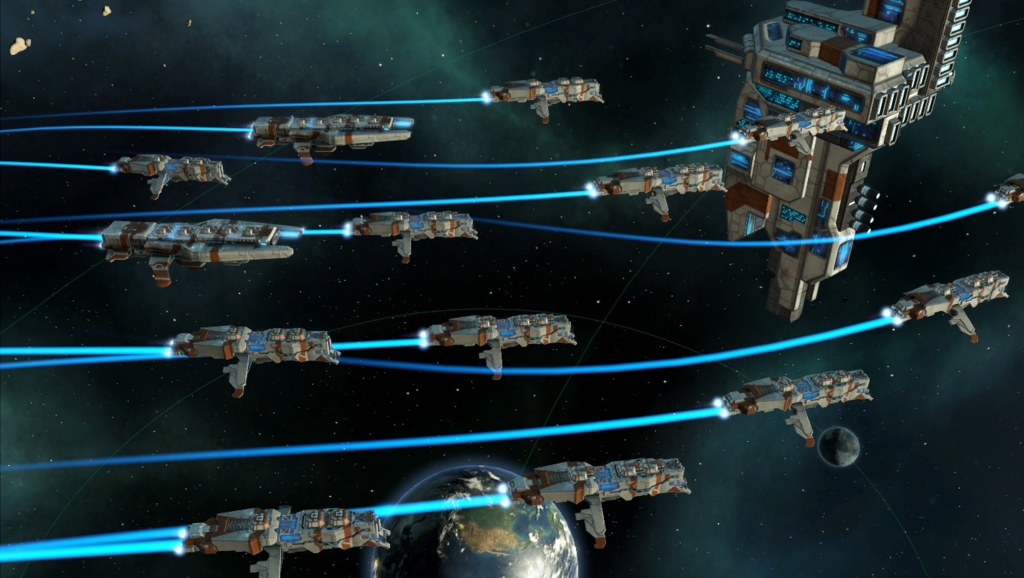
The ENC fleet returns to Earth after defeating the Uri Dominion.
The Earth Naval Coalition emerged victorious from its first interstellar war, but not without its share of suffering and trial. 29 warships left Earth's orbit to battle the Uri Dominion; only 14 returned home, and several of them were severely damaged and had suffered extensive crew casualties. The mission was presented to the public as a success, and a great victory for galactic freedom. Triumphant video clips of the fleet warping back into Sol played repeatedly on news broadcasts, and public morale at the victory was high.
Within the ENC and the political elite of the UN, however, the mood was anything but joyous. Admiral von Boyen might have been a victor, but she was not a hero. Her fleet had done well enough taking down space stations and bombarding planets, but it had utterly failed in its first engagement against another stellar navy. Everyone -- including von Boyen herself -- knew that the Karabnar had won the war and saved the lives of any humans who made it back home at the end of the war. While she was a hero to the poorly-informed masses, von Boyen became an outcast among her peers in the Coalition. She took to isolation and heavy drinking, and died in 2235, a year after the war's conclusion, of officially unknown causes.
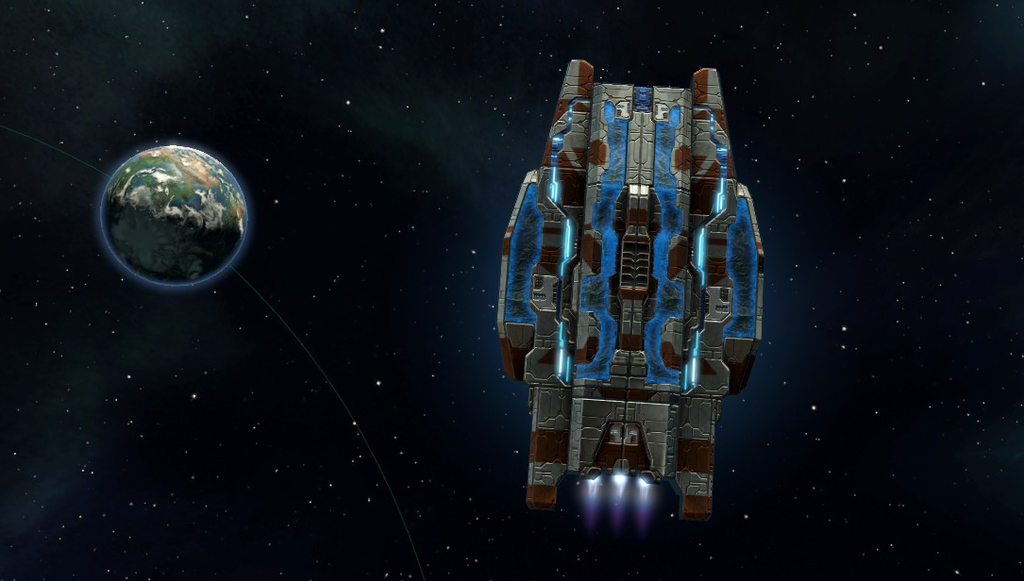
Not long after the war concluded, the ENC dispatched a colony vessel to Alpha Centauri IIa, and colonized the moon as New Verona, named for the capitol of Lombardia, a chief economic sponsor of the venture. With a victorious war and a new colony, the public was placated. Internally, however, the ENC was operating in a state of panic. The Coalition had more problems than solutions, and the years following the invasion of the Dominion were filled with a frantic search for answers.
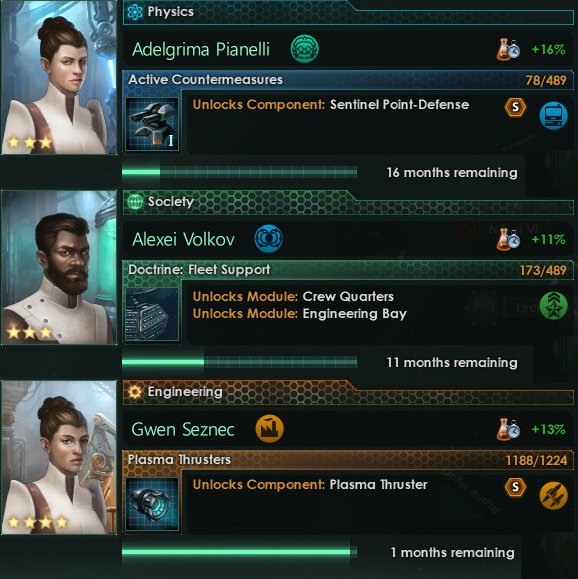
Militarily, President Hunter ordered a major initiative to upgrade and expand the Coalition warfleet. The fleet was 29 strong at the beginning of the war, and Hunter ordered its expansion to a minimum of 50 warships. Additionally, she directed all of her research departments to focus on developing new technology useful for combat starships. The projects included a new-model plasma-powered thruster system, to allow for greater speed and maneuverability in combat; rapid-firing point-defense guns, to defend against the Uri's powerful missile barrages; and spaceport modules design to make the repair and maintenance of the fleet more efficient. No matter what, President Hunter was determined that the ENC would be infinitely more prepared for its second war.
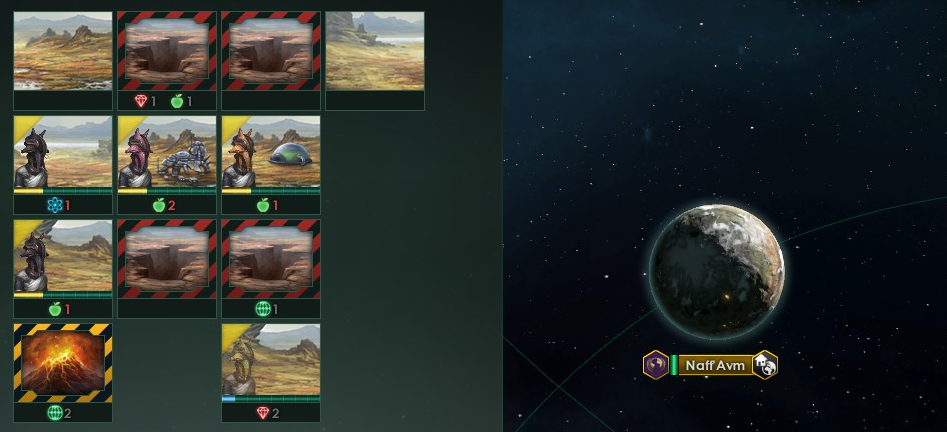
Politically, Hunter now had to deal with a planet full of Urian citizens who were none too pleased about their invasion. Naff'Avm was, legally speaking, now under ENC jurisdiction, but many of its citizens still remained loyal to the Uri Dominion. The years following the war were difficult ones; it didn't take long for protests to be organized on the moon colony, with a faction of activists banding together to demand repatriation into the Dominion. President Hunter, worried that the protests could turn violent, left two divisions of human assault troops on the planet, and raised two divisions of loyalist Uri defense forces to help secure the planet in cooperation with the local garrison. Thankfully, Hunter's decision was wise; it took only a few months for the first acts of sabotage to begin. Government administrative buildings and resource collection sites were routinely bombed by rebel elements, forcing a continual investment of resources to rebuild lost and damaged facilities. In the election of 2240, the disgruntled Uri even put forth a presidential candidate from their faction; a purely symbolic gesture, as Coalition law permitted only humans to hold the office of President.
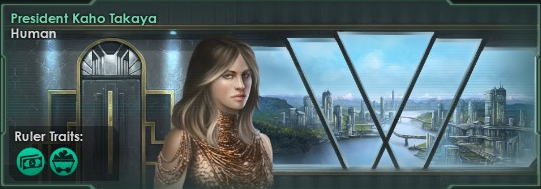
The winner of the election was Kaho Takaya, an economically-savy leader who saw the unrest on Naff'Avm as an unacceptable resource drain. She enacted harsher policies against the repatriation movement, and showed a further act of defiance to the Dominion by taking on the Uri Confedracy, released after the war, as a protected vassal-state under ENC oversight. The harsh crackdowns ordered by Takaya pushed the Uri rebels over the edge, and they finally took up arms in 2244 to attempt a violent overthrow of the planet.
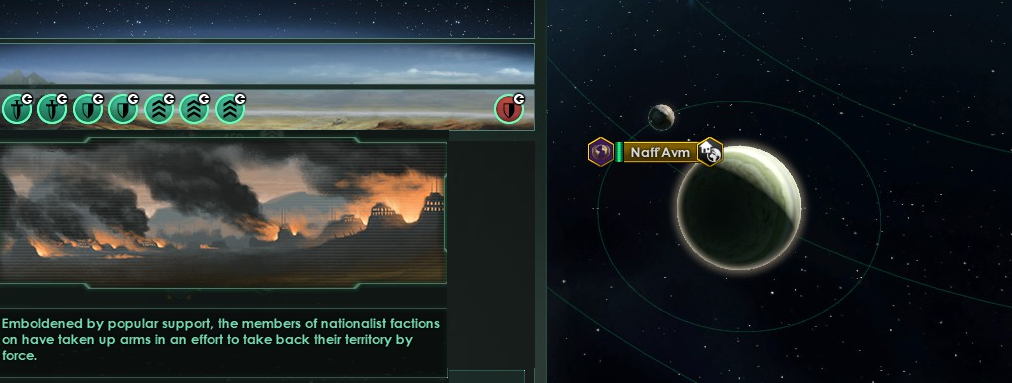
The rebels, however, were poorly equipped and small in number; against the combined forces of the local garrison and four professional army units, the armed separatists stood little change. The fighting lasted for only a week or so, and the rebel movement was crushed definitively. With most of their fighters dead and their leaders imprisoned, the repatriation faction was disbanded -- it took the better part of a decade, but Naff'Avm was finally integrated. As colonization efforts continued to expand, Naff'Avm was appointed a Human governor and made the namesake and capital of the Naff'Avm Sector, which would eventually come to incorporate the ENC's southern colony worlds closest to the Uri border.
Into the Drift
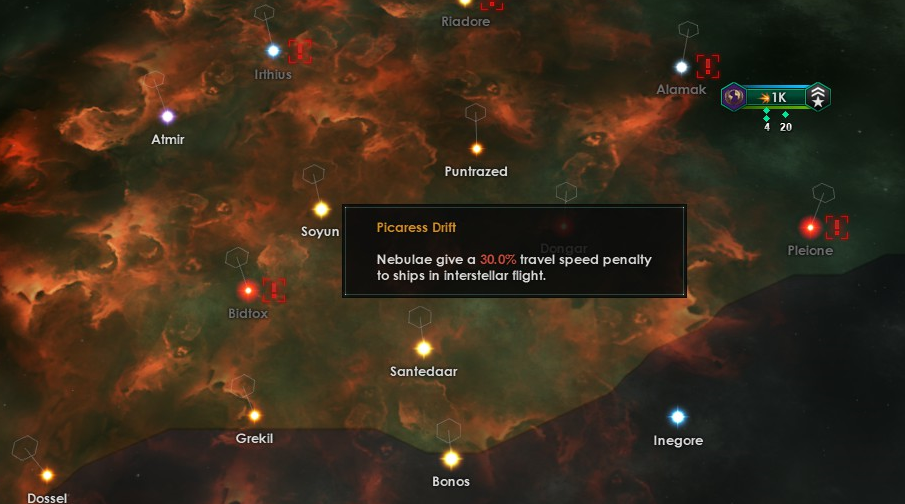
As the Coalition encountered an ever-growing number of sovereign states, navigating through space to continue exploring new regions became increasingly difficult, as the majority of these star empires were very protective of their claimed regions. However, nestled in between the southern border of the Celimy and the norther border of the Bokasheran was the Picaress Drift, a nebula region containing a number of stars not claimed by either party. Taking advantage of this, Presidents Hunter and Takaya sent their ships out into the nebula, surveying as many systems as they could reach.
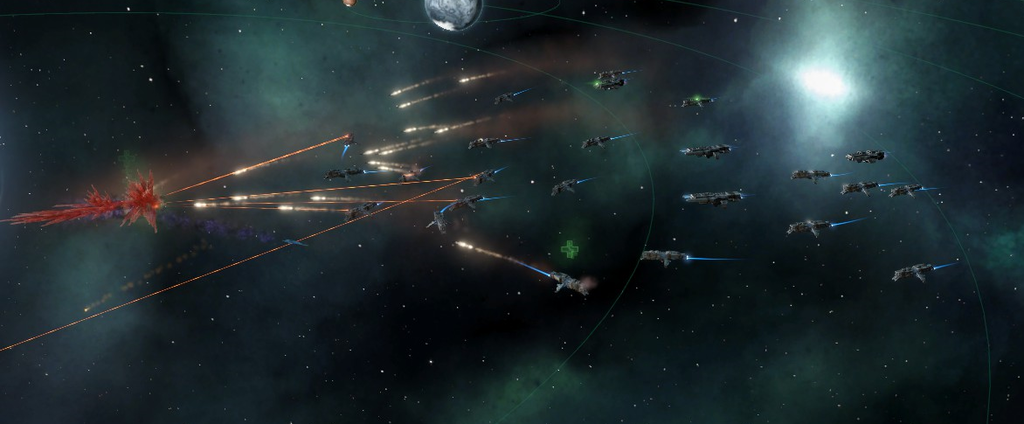
It was there that they first encountered a species of strange, crystalline-looking beings that warded off Dr. Sant Mikael's vessel on its first arrival. These beings inhabited multiple systems within the nebula, and the ENC fleet was dispatched to deal with them in a series of skirmishes. The creatures seemed to use portions of their own body as weapons, launching weaponized crystal fragments at the ENC ships. After several of them were destroyed, Coalition scientists began working on a way of reverse-engineering and mimicking these weapons, hoping to add them into the fleet's arsenal.
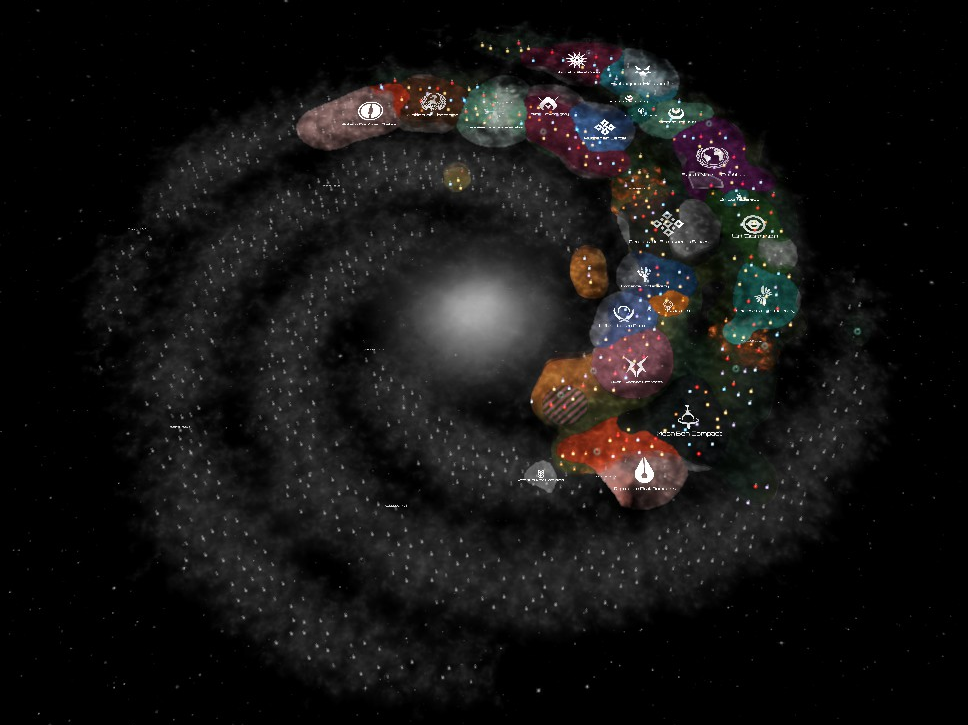
As the fleet surveyed further, it became apparent that not only was man not alone in the stars; he was actually a resident of a quite crowded region of space.
2234 - 2244 AD: The War's Aftermath
Post-War Challenges

The ENC fleet returns to Earth after defeating the Uri Dominion.
The Earth Naval Coalition emerged victorious from its first interstellar war, but not without its share of suffering and trial. 29 warships left Earth's orbit to battle the Uri Dominion; only 14 returned home, and several of them were severely damaged and had suffered extensive crew casualties. The mission was presented to the public as a success, and a great victory for galactic freedom. Triumphant video clips of the fleet warping back into Sol played repeatedly on news broadcasts, and public morale at the victory was high.
Within the ENC and the political elite of the UN, however, the mood was anything but joyous. Admiral von Boyen might have been a victor, but she was not a hero. Her fleet had done well enough taking down space stations and bombarding planets, but it had utterly failed in its first engagement against another stellar navy. Everyone -- including von Boyen herself -- knew that the Karabnar had won the war and saved the lives of any humans who made it back home at the end of the war. While she was a hero to the poorly-informed masses, von Boyen became an outcast among her peers in the Coalition. She took to isolation and heavy drinking, and died in 2235, a year after the war's conclusion, of officially unknown causes.

Not long after the war concluded, the ENC dispatched a colony vessel to Alpha Centauri IIa, and colonized the moon as New Verona, named for the capitol of Lombardia, a chief economic sponsor of the venture. With a victorious war and a new colony, the public was placated. Internally, however, the ENC was operating in a state of panic. The Coalition had more problems than solutions, and the years following the invasion of the Dominion were filled with a frantic search for answers.

Militarily, President Hunter ordered a major initiative to upgrade and expand the Coalition warfleet. The fleet was 29 strong at the beginning of the war, and Hunter ordered its expansion to a minimum of 50 warships. Additionally, she directed all of her research departments to focus on developing new technology useful for combat starships. The projects included a new-model plasma-powered thruster system, to allow for greater speed and maneuverability in combat; rapid-firing point-defense guns, to defend against the Uri's powerful missile barrages; and spaceport modules design to make the repair and maintenance of the fleet more efficient. No matter what, President Hunter was determined that the ENC would be infinitely more prepared for its second war.

Politically, Hunter now had to deal with a planet full of Urian citizens who were none too pleased about their invasion. Naff'Avm was, legally speaking, now under ENC jurisdiction, but many of its citizens still remained loyal to the Uri Dominion. The years following the war were difficult ones; it didn't take long for protests to be organized on the moon colony, with a faction of activists banding together to demand repatriation into the Dominion. President Hunter, worried that the protests could turn violent, left two divisions of human assault troops on the planet, and raised two divisions of loyalist Uri defense forces to help secure the planet in cooperation with the local garrison. Thankfully, Hunter's decision was wise; it took only a few months for the first acts of sabotage to begin. Government administrative buildings and resource collection sites were routinely bombed by rebel elements, forcing a continual investment of resources to rebuild lost and damaged facilities. In the election of 2240, the disgruntled Uri even put forth a presidential candidate from their faction; a purely symbolic gesture, as Coalition law permitted only humans to hold the office of President.

The winner of the election was Kaho Takaya, an economically-savy leader who saw the unrest on Naff'Avm as an unacceptable resource drain. She enacted harsher policies against the repatriation movement, and showed a further act of defiance to the Dominion by taking on the Uri Confedracy, released after the war, as a protected vassal-state under ENC oversight. The harsh crackdowns ordered by Takaya pushed the Uri rebels over the edge, and they finally took up arms in 2244 to attempt a violent overthrow of the planet.

The rebels, however, were poorly equipped and small in number; against the combined forces of the local garrison and four professional army units, the armed separatists stood little change. The fighting lasted for only a week or so, and the rebel movement was crushed definitively. With most of their fighters dead and their leaders imprisoned, the repatriation faction was disbanded -- it took the better part of a decade, but Naff'Avm was finally integrated. As colonization efforts continued to expand, Naff'Avm was appointed a Human governor and made the namesake and capital of the Naff'Avm Sector, which would eventually come to incorporate the ENC's southern colony worlds closest to the Uri border.
Into the Drift

As the Coalition encountered an ever-growing number of sovereign states, navigating through space to continue exploring new regions became increasingly difficult, as the majority of these star empires were very protective of their claimed regions. However, nestled in between the southern border of the Celimy and the norther border of the Bokasheran was the Picaress Drift, a nebula region containing a number of stars not claimed by either party. Taking advantage of this, Presidents Hunter and Takaya sent their ships out into the nebula, surveying as many systems as they could reach.

It was there that they first encountered a species of strange, crystalline-looking beings that warded off Dr. Sant Mikael's vessel on its first arrival. These beings inhabited multiple systems within the nebula, and the ENC fleet was dispatched to deal with them in a series of skirmishes. The creatures seemed to use portions of their own body as weapons, launching weaponized crystal fragments at the ENC ships. After several of them were destroyed, Coalition scientists began working on a way of reverse-engineering and mimicking these weapons, hoping to add them into the fleet's arsenal.

As the fleet surveyed further, it became apparent that not only was man not alone in the stars; he was actually a resident of a quite crowded region of space.
So much of the galaxy remains unexplored, but you're going to have a hard time expanding there if you want your territory to connect.
Also, I feel bad for Admiral von Boyen. It wasn't her fault the ENC wasn't ready for the war.
Also, I feel bad for Admiral von Boyen. It wasn't her fault the ENC wasn't ready for the war.
Yeah, the only way to expand now is going to be through conquest... Guess I'd better prepare to take another swing at the Uri!
I didn't notice the large unoccupied space next to you on the arm over. That's quite fortunate for you, seeing as everywhere else is crowded. Also be careful when clearing out those hostile aliens. Your neighbours might swoop in and take the nearby star systems now that the region is safe. I've had that happen before.
I didn't notice the large unoccupied space next to you on the arm over. That's quite fortunate for you, seeing as everywhere else is crowded. Also be careful when clearing out those hostile aliens. Your neighbours might swoop in and take the nearby star systems now that the region is safe. I've had that happen before.
With my luck, there's probably a Fallen Empire lurking somewhere in the cloud.
A magnificent start Red! Really enjoying the reach for the stars thing.
It's not so much about the Lombards but that's fine as your story telling expertise has neatly segued into this new milieu
It's not so much about the Lombards but that's fine as your story telling expertise has neatly segued into this new milieu
A magnificent start Red! Really enjoying the reach for the stars thing.
It's not so much about the Lombards but that's fine as your story telling expertise has neatly segued into this new milieu
Well I thought about having a Lombard one-world empire, but it didn't feel all that plausible... So I just ran with what I thought might happen
And your instinct was the right one mr!Well I thought about having a Lombard one-world empire, but it didn't feel all that plausible... So I just ran with what I thought might happen
Humanity Marks a Half-Century in Space
2244 - 2260 AD: The ENC Shows Dominance
Presidential Politics
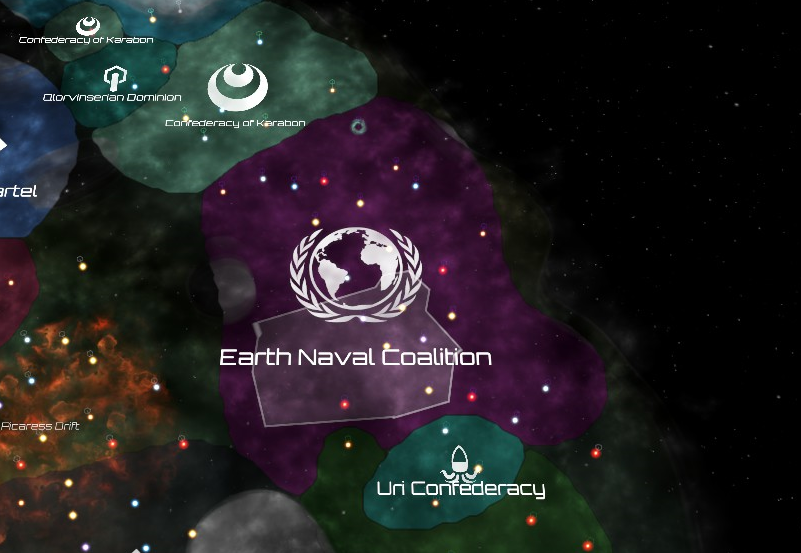
President Takaya's term continued peacefully through the 2240's, as the Earth Naval Coalition refocused its efforts to strengthen itself militarily and politically in the aftermath of the difficult victory over the Uri Dominion. A new colony in the Unar system became the fifth planet directly controlled by the ENC staff, while Naff'Avm remained in a separately-governed sector left to a certain degree of autonomy. Not only did this cut down on the size of the ENC bureaucracy, but it allowed the conquered Urian people to maintain some limited distance from the main state of their human overlords, helping to ease their integration into society. The one-world Uri Confederacy, which had been liberated at the Karabnar's request during the war, accepted an offer to be formally integrated into the ENC, beginning a years-long process of transitioning its government into the Naff'Avm sector. By grouping the former Confederacy into the Naff'Avm sector, President Takaya hoped that the Uri of both planets would help one another to integrate into human society.
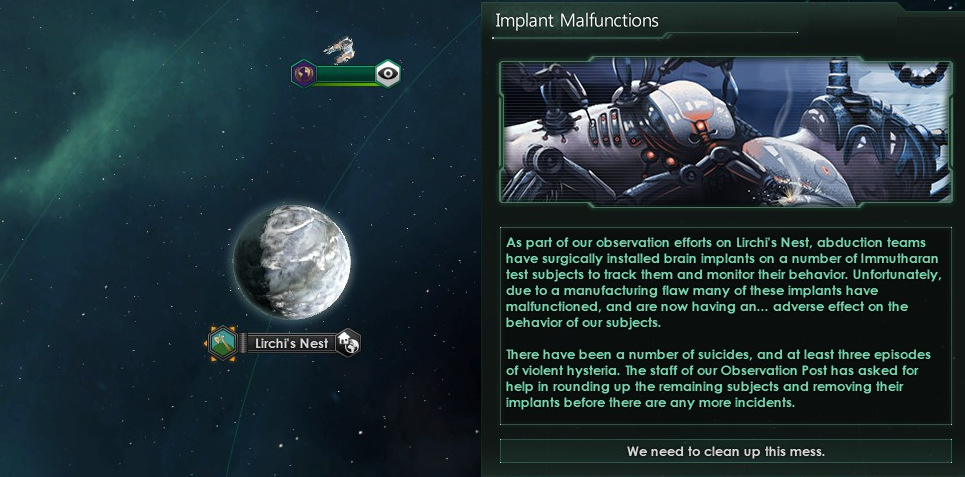
The end of her term, however, was marked with a controversy that generated a great stir back on earth and within the hierarchy of the ENC. When Dr. Rioc Sant Mikael died in 2248, the secrecy surrounding his unauthorized abductions and experimentation on the iron-age Immutharan population of Lirchi's Nest came to light thanks to a malfunction in covert brain implants used to monitor Immutharen society. Suicides, mental episodes, and rapid and irrational changes in behavior were just some of the side effects observed. When word was leaked that the project had gone awry, it brought the experiments -- which had been expressly forbidden -- into the public news cycle and into political discourse. Humanitarian groups at home, and many states -- particularly in South America and northern Europe -- protested vocally and openly condemned such intrusive manipulation of a native species.
In an attempt to control the damage done, President Takaya ordered the suspension of the observation post's chief executive and appointed an investigatory committee to thoroughly examine the station's operations. Unfortunately for her, the people were not satisfied; the scandal had broken on her watch, and many of the leading states of the United Nations demanded accountability. When the election of 2250 came, Takaya was ousted from office in favor of former President Christina Hunter, elected for another term in office. Takaya quietly disappeared from the public eye, and the Lirchi's Nest controversy faded from the media as President Hunter returned to duty.
A New Kind of Immigrant
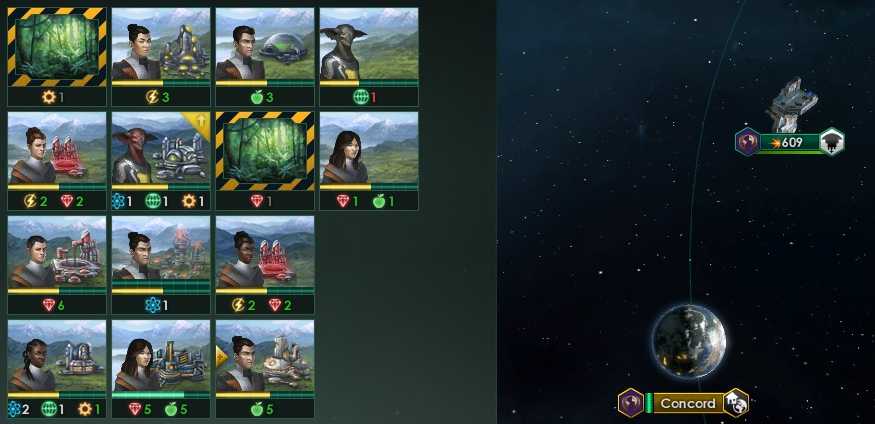
One of the first questions on President Hunter's agenda after she returned to office was the issue of immigration and inter-species relations within ENC-controlled territory. With the capture of Naff'Avm, the ENC now controlled planets with two different species; furthermore, several other star nations had petitioned the ENC to enter into migration rights agreements. While it was already legal for Karabnar to immigrate into ENC land, none of them had done so; but the Celimy and Bokasheran also sought to open up avenues for travel between the nations.
The topic was a difficult one, primarily for economic reasons, and opinions varied sharply on different worlds. On Earth, interest in immigration was minimal; the possibility non-Human species were not warmly welcomed on Earth. Additionally, the migration of Humans to other regions was seen as an economic defeat, as there would be fewer Humans ready and available to staff planetary facilities. Among the colonies, however, the initiative gained more traction. Particularly on the colonies of Concord and Sant Mikael, the notion of allowing free migration gained strong support. Ultimately, the measure passed, and immigration agreements were reached with the Democratic Bokasheran States and the Celimy Sovereignty. Initially, a large number of human colonists, especially from Sant Mikael, began to migrate into Bokasheran territory, specifically to the lush gaia world of Ka'Tanab, where they lived alongside native Bokasherans and Ruphaari.
Concord was the first Human colony to receive immigrants from another interstellar state -- the Tuxkan, a species uplifted by the Celimy, were well-suited to continental worlds, and a number of their people began to migrate from Celimy territory into Concord, making it the first planet under ENC control to house multiple species on the same world. It was on Concord that the first conversations about inter-species suffrage and colonial representation began to occur; Uri and Tuxkan populations expected some form of participation in the ENC government, and as the number of Human colonies grew, their willingness to be governed by a council of nations on Earth began to grow thin. Small political movements began to crop up, but these sentiments would continue to grow for several years.
The Karabnar - Hathgum Liberation War

In November of 2252, the Confederacy of Karabon's President Malugrebb turned his attention to his neighbor to the north and long-declared rival, the Hathgum Hierarchy. The Karabnar were true to their mothodology, and didn't seek to gain any territory from the Hierarchy; instead, the Karabnar intended to force Empress Sler'huss I to release a number of worlds into a free, democratic state. In an age where many states were forming bi- and tri-lateral alliances, the Hathgum remained isolated; and therefore vulnerable.
The Hathgum were not an immediate threat to the Humans, and President Hunter was more concerned with planning her next attack against the Uri, but she nevertheless pledged her support to the Karabnar, Humanity's first and most trusted allies. A victory would weaken a potential rival and strengthen the position of their allies, hopefully leading to a chance to once again strike southward.
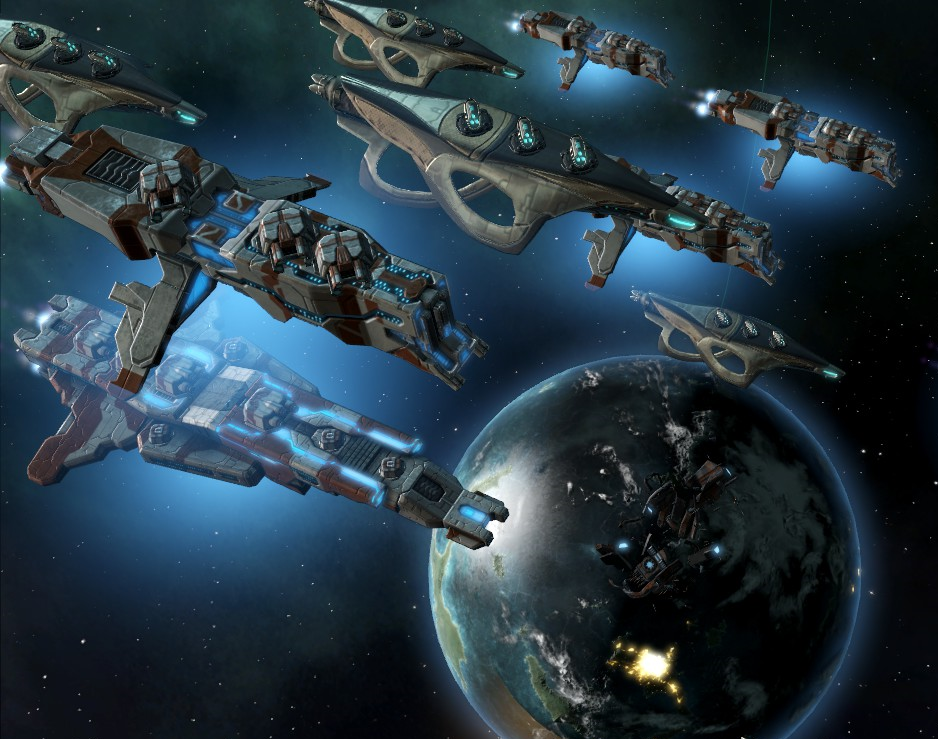
The ENC's new Oloron-class cruiser (bottom) during the bombardment of Davi'Hunis.
The ENC's naval forces had advanced considerably since its first armed conflict. The poor performance of the Coalition fleet against the Uri had sparked substantial investment (and corresponding advancement) in ship technology, leading to multiple new types of weaponry and defenses. The Karabnar-Hathum Liberation War was noteworthy in being the first conflict that saw the deployment of the Coalition's new Cruiser-class vessels, including the Oloron-class, a long-range ship utilizing the newest class of missile weapons, and the Breton-class, the ENC's first light carrier and the first ship to mount shard throwers engineered from the mysterious Crystalline Beings.
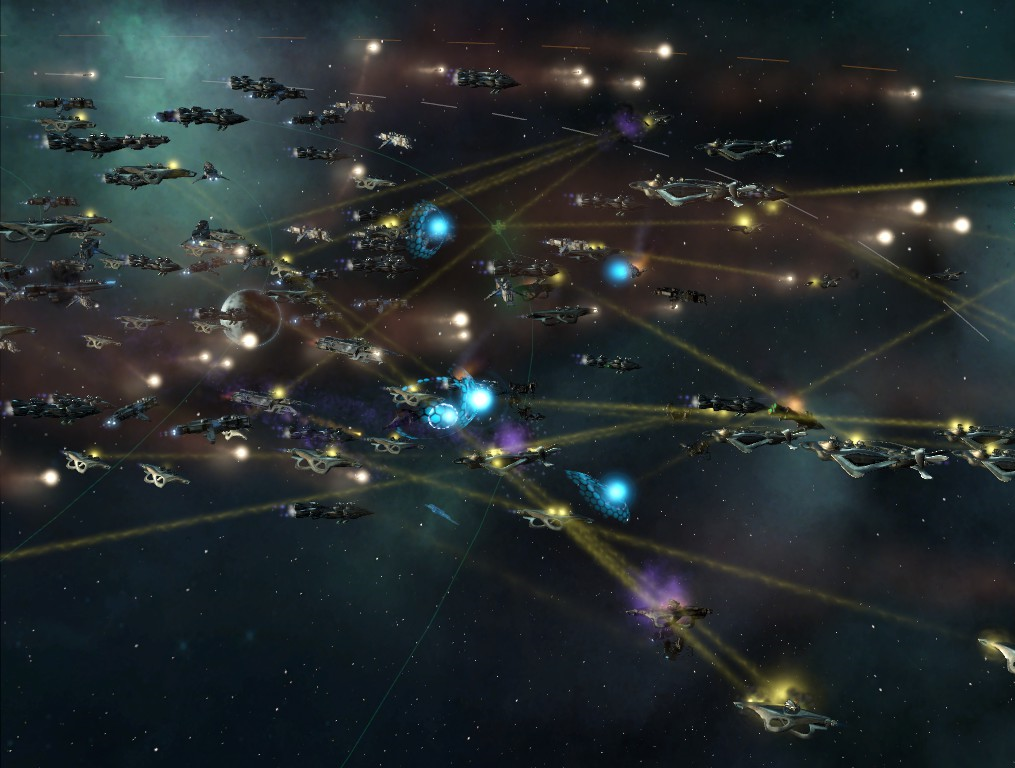
The Hathgum were politically reclusive, but far from unprepared for battle. After the fall of Davi'Hunis, the Hierarchy fleet engaged the joint forces of the Human and Karabnar in an extended battle, with a force that challenged the combined might of their attackers. Their ships employed short-ranged but exceptionally powerful disruptor weapons, capable of penetrating armor with ease. The Coalition ships that relied on deflector shields for defense did well in the battle, but many armor-based vessels were sunk during the engagement.
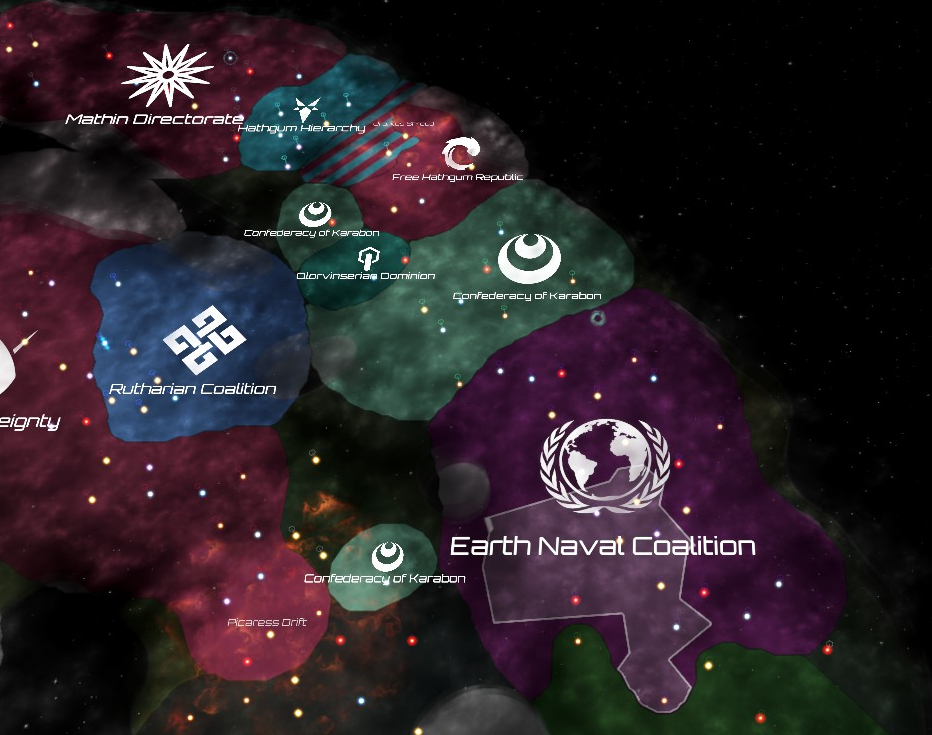
The battle went on for weeks before it was decided in favor of the Human-Karabnar Alliance, and the Hathgum Hierarchy was forced to concede 6 of its 11 worlds into a newly-formed "Free Hathgum Republic," a Democratic state with its first president established under Karabnar guidance. The victory was a decisive one for both factions. The Karabnar managed to cut the strength of a major rival in half and create one more free nation in space; the Humans showed that they had learned from their failure agains the Uri and were, in fact, capable of waging an effective war for the stars.
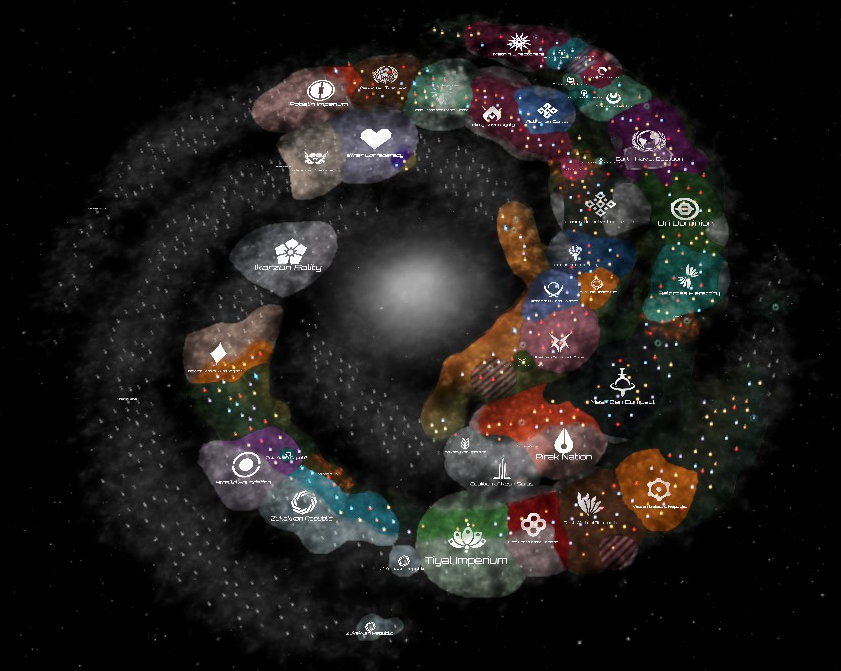
When it came time to elect a new president in 2260 AD, Christina Hunter's success alongside the Karabnar against the Hathgum gained her immense popular support; she was elected to yet another term as ENC President, and she made a bold promise that Humanity was not done with its interstellar nation-building; it was time to challenge the Uri again.
2244 - 2260 AD: The ENC Shows Dominance
Presidential Politics

President Takaya's term continued peacefully through the 2240's, as the Earth Naval Coalition refocused its efforts to strengthen itself militarily and politically in the aftermath of the difficult victory over the Uri Dominion. A new colony in the Unar system became the fifth planet directly controlled by the ENC staff, while Naff'Avm remained in a separately-governed sector left to a certain degree of autonomy. Not only did this cut down on the size of the ENC bureaucracy, but it allowed the conquered Urian people to maintain some limited distance from the main state of their human overlords, helping to ease their integration into society. The one-world Uri Confederacy, which had been liberated at the Karabnar's request during the war, accepted an offer to be formally integrated into the ENC, beginning a years-long process of transitioning its government into the Naff'Avm sector. By grouping the former Confederacy into the Naff'Avm sector, President Takaya hoped that the Uri of both planets would help one another to integrate into human society.

The end of her term, however, was marked with a controversy that generated a great stir back on earth and within the hierarchy of the ENC. When Dr. Rioc Sant Mikael died in 2248, the secrecy surrounding his unauthorized abductions and experimentation on the iron-age Immutharan population of Lirchi's Nest came to light thanks to a malfunction in covert brain implants used to monitor Immutharen society. Suicides, mental episodes, and rapid and irrational changes in behavior were just some of the side effects observed. When word was leaked that the project had gone awry, it brought the experiments -- which had been expressly forbidden -- into the public news cycle and into political discourse. Humanitarian groups at home, and many states -- particularly in South America and northern Europe -- protested vocally and openly condemned such intrusive manipulation of a native species.
In an attempt to control the damage done, President Takaya ordered the suspension of the observation post's chief executive and appointed an investigatory committee to thoroughly examine the station's operations. Unfortunately for her, the people were not satisfied; the scandal had broken on her watch, and many of the leading states of the United Nations demanded accountability. When the election of 2250 came, Takaya was ousted from office in favor of former President Christina Hunter, elected for another term in office. Takaya quietly disappeared from the public eye, and the Lirchi's Nest controversy faded from the media as President Hunter returned to duty.
A New Kind of Immigrant

One of the first questions on President Hunter's agenda after she returned to office was the issue of immigration and inter-species relations within ENC-controlled territory. With the capture of Naff'Avm, the ENC now controlled planets with two different species; furthermore, several other star nations had petitioned the ENC to enter into migration rights agreements. While it was already legal for Karabnar to immigrate into ENC land, none of them had done so; but the Celimy and Bokasheran also sought to open up avenues for travel between the nations.
The topic was a difficult one, primarily for economic reasons, and opinions varied sharply on different worlds. On Earth, interest in immigration was minimal; the possibility non-Human species were not warmly welcomed on Earth. Additionally, the migration of Humans to other regions was seen as an economic defeat, as there would be fewer Humans ready and available to staff planetary facilities. Among the colonies, however, the initiative gained more traction. Particularly on the colonies of Concord and Sant Mikael, the notion of allowing free migration gained strong support. Ultimately, the measure passed, and immigration agreements were reached with the Democratic Bokasheran States and the Celimy Sovereignty. Initially, a large number of human colonists, especially from Sant Mikael, began to migrate into Bokasheran territory, specifically to the lush gaia world of Ka'Tanab, where they lived alongside native Bokasherans and Ruphaari.
Concord was the first Human colony to receive immigrants from another interstellar state -- the Tuxkan, a species uplifted by the Celimy, were well-suited to continental worlds, and a number of their people began to migrate from Celimy territory into Concord, making it the first planet under ENC control to house multiple species on the same world. It was on Concord that the first conversations about inter-species suffrage and colonial representation began to occur; Uri and Tuxkan populations expected some form of participation in the ENC government, and as the number of Human colonies grew, their willingness to be governed by a council of nations on Earth began to grow thin. Small political movements began to crop up, but these sentiments would continue to grow for several years.
The Karabnar - Hathgum Liberation War

In November of 2252, the Confederacy of Karabon's President Malugrebb turned his attention to his neighbor to the north and long-declared rival, the Hathgum Hierarchy. The Karabnar were true to their mothodology, and didn't seek to gain any territory from the Hierarchy; instead, the Karabnar intended to force Empress Sler'huss I to release a number of worlds into a free, democratic state. In an age where many states were forming bi- and tri-lateral alliances, the Hathgum remained isolated; and therefore vulnerable.
The Hathgum were not an immediate threat to the Humans, and President Hunter was more concerned with planning her next attack against the Uri, but she nevertheless pledged her support to the Karabnar, Humanity's first and most trusted allies. A victory would weaken a potential rival and strengthen the position of their allies, hopefully leading to a chance to once again strike southward.

The ENC's new Oloron-class cruiser (bottom) during the bombardment of Davi'Hunis.
The ENC's naval forces had advanced considerably since its first armed conflict. The poor performance of the Coalition fleet against the Uri had sparked substantial investment (and corresponding advancement) in ship technology, leading to multiple new types of weaponry and defenses. The Karabnar-Hathum Liberation War was noteworthy in being the first conflict that saw the deployment of the Coalition's new Cruiser-class vessels, including the Oloron-class, a long-range ship utilizing the newest class of missile weapons, and the Breton-class, the ENC's first light carrier and the first ship to mount shard throwers engineered from the mysterious Crystalline Beings.

The Hathgum were politically reclusive, but far from unprepared for battle. After the fall of Davi'Hunis, the Hierarchy fleet engaged the joint forces of the Human and Karabnar in an extended battle, with a force that challenged the combined might of their attackers. Their ships employed short-ranged but exceptionally powerful disruptor weapons, capable of penetrating armor with ease. The Coalition ships that relied on deflector shields for defense did well in the battle, but many armor-based vessels were sunk during the engagement.

The battle went on for weeks before it was decided in favor of the Human-Karabnar Alliance, and the Hathgum Hierarchy was forced to concede 6 of its 11 worlds into a newly-formed "Free Hathgum Republic," a Democratic state with its first president established under Karabnar guidance. The victory was a decisive one for both factions. The Karabnar managed to cut the strength of a major rival in half and create one more free nation in space; the Humans showed that they had learned from their failure agains the Uri and were, in fact, capable of waging an effective war for the stars.

When it came time to elect a new president in 2260 AD, Christina Hunter's success alongside the Karabnar against the Hathgum gained her immense popular support; she was elected to yet another term as ENC President, and she made a bold promise that Humanity was not done with its interstellar nation-building; it was time to challenge the Uri again.
Last edited:
Hey, humanity has learned how to fight these new wars. Now you just need to win on your own, to show the galaxy that humanity will become a force to be reckoned with in space.
The ever-growing alien population in the ENC will likely remain an issue until it's officially addressed. Will they gain more representation, or will the divided humans deny them?
The ever-growing alien population in the ENC will likely remain an issue until it's officially addressed. Will they gain more representation, or will the divided humans deny them?
Looks like the ENC is getting cut off on the side there now. War is the only option.
I may not have read the previous two AARs set in this world but with the nice recap at the start I feel Like I learnt all I needed to know. The story you are telling is great, every point simple and short. I can't wait to see the next chapter.
I second that.I may not have read the previous two AARs set in this world but with the nice recap at the start I feel Like I learnt all I needed to know. The story you are telling is great, every point simple and short. I can't wait to see the next chapter.
Glad to hear that!! I was a little concerned those who didn't read the first two AARs of this timeline would feel a bit confused/annoyed, but that doesn't seem to be the case  I'm glad that people are enjoying reading it, I'm having a blast writing it.
I'm glad that people are enjoying reading it, I'm having a blast writing it.

